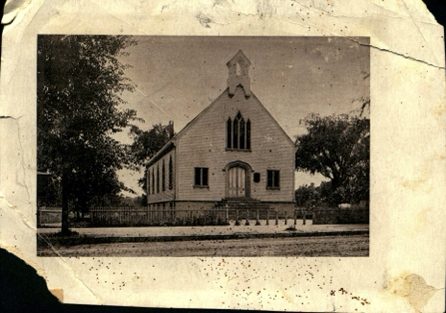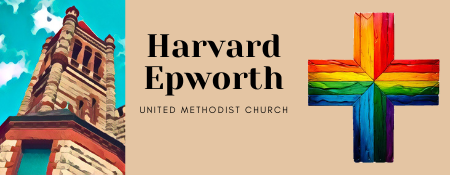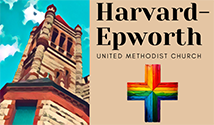How a Chapel in Old Cambridge Became a Pillar of Liberal New England Methodism

Harvard-Epworth traces its history back to 1790, when pioneering preacher Jesse Lee made his first visit to Boston. In 1792 Lee helped organize the city’s first Methodist society. In the early 1800s, “praying bands” of Methodists organized across the Charles River, in East Cambridge. Ebenezer Chapel, founded in 1823, became a mother church for several others, including the Harvard Street Society, which built an East Cambridge church in 1843.
North Avenue Methodist, Harvard-Epworth’s predecessor, was organized in 1868 with the support of Harvard Street Methodist. (North Avenue took its name from the street, which was later renamed Massachusetts Avenue.) Three earlier efforts to form a church in Old Cambridge – the Cambridge of Harvard College and Brattle Street – were short-lived. But North Avenue thrived, with Rev. Abraham Merrill as its first pastor and Harvard College students as a mission. The first church building, a whitewashed frame chapel, was located just across the road from the north end of Cambridge Common.
“Splendid Epworth”
North Avenue Methodist, Harvard-Epworth’s predecessor, was organized in 1868 with the support of Harvard Street Methodist. (North Avenue took its name from the street, which was later renamed Massachusetts Avenue.) Three earlier efforts to form a church in Old Cambridge – the Cambridge of Harvard College and Brattle Street – were short-lived. But North Avenue thrived, with Rev. Abraham Merrill as its first pastor and Harvard College students as a mission. The first church building, a whitewashed frame chapel, was located just across the road from the north end of Cambridge Common.
Worcester architect Amos Cutting was chosen for the project, with the Cutting and Bishop construction firm as contractor. Cutting’s Richardsonian Romanesque design featured a light red granite and red sandstone exterior, with a 110-foot tower with no bell. Stained glass windows would decorate the sanctuary, which would have curved, auditorium-style pews, and a new George Hutchings organ. Groundbreaking was held in October 1891 and the chapel was demolished. During construction the congregation met in Brattle Hall in Harvard Square and Harvard’s Appleton Chapel. In 1892 the church’s name was changed to Epworth Methodist Episcopal, from the England birthplace of Methodism founder John Wesley.
“Splendid Epworth,” as a Methodist historian dubbed it, was dedicated on Feb. 22, 1893, amid the last hours of a fierce northeaster. Rindge contributed a total of $53,500 of the project’s $73,000 cost, the equivalent of $1.4 million out of $2 million in 2020. The balance was raised from more than 500 other donors, including a penny from 12-year-old church member Eva Griffin.
Through the decades that followed, Epworth proclaimed the Gospel, campaigned for temperance, aided the poor of Cambridge, and helped European immigrants who arrived by ship at the Boston docks. During the last year of World War I, the Rev. Elmer Leslie provided evening study space and a canteen for U.S. Navy sailors getting “radio school” training. That fall the church weathered the 1918 Spanish flu pandemic. At the pandemic’s peak Epworth was closed for three consecutive Sundays. The church prospered in the Roaring Twenties, then endured “the hardest years” of the Great Depression. Epworth and Harvard Street Methodist formally merged in November 1941, weeks before the Japanese attack on Pearl Harbor plunged the United States into World War II.
Social Missions and “Liberal Evangelism”
Harvard-Epworth’s membership and activity boomed in the Eisenhower Fifties. In the late ‘50s and early ‘60s, Rev. Daniel Whitsett led the church into a mission of racial justice and reconciliation. The Student Nonviolent Coordinating Committee, a civil rights group, ran a regional office in the church basement. As the Vietnam War and 1960s counterculture challenged the congregation, Rev. Ed Mark preached against the war. He also screened a popular weekly film series that drew local audiences for 31 years.
When Rev. Scott Campbell succeeded Mark in 1996, gay and lesbian rights and help for the homeless became our signature social-justice issues. In 1999 the church voted to become a Reconciling Ministries Network congregation, open and welcoming to gay, lesbian, bisexual and transgender persons. A year later, in 2000, the Youth On Fire daytime shelter for homeless teens and young adults moved into basement space that had originally been the church’s dining hall. Youth On Fire stayed for 15 years. The Outdoor Church of Cambridge began operating from the basement in 2009, and is still there.
Those social missions have continued since Rev. Herb Taylor succeeded Campbell in 2014. Taylor led a group of members to visit holy sites in Israel and the West Bank. In 2019 a mission group went to Puerto Rico, a year after Hurricane Maria devastated the island. In the spring of 2020 the Covid-19 pandemic forced the church to close its doors for months. But even then, Harvard-Epworth continued to find ways to share its message of what Taylor called “liberal evangelism.” Our church’s missions have changed since Rev. Merrill and our spiritual ancestors first gathered here, but our call has not.

